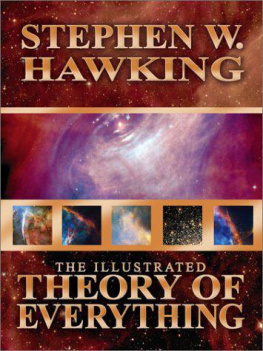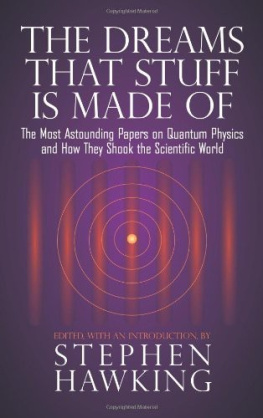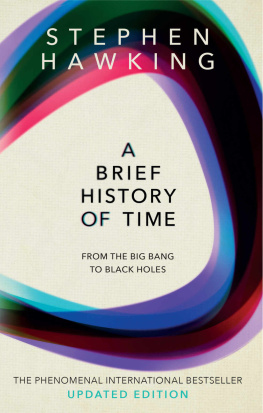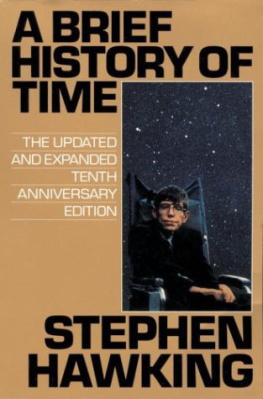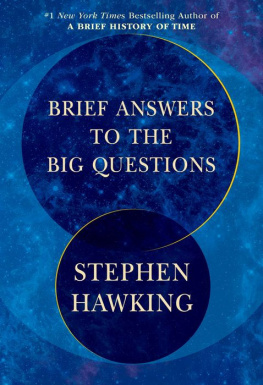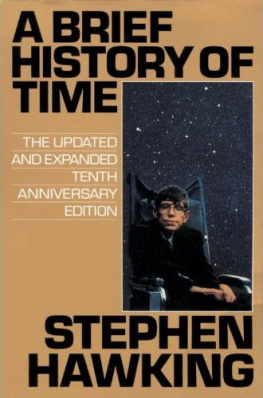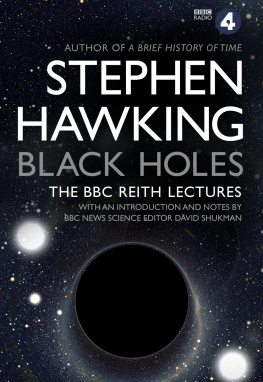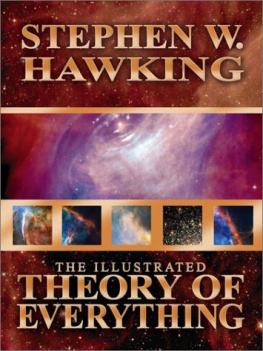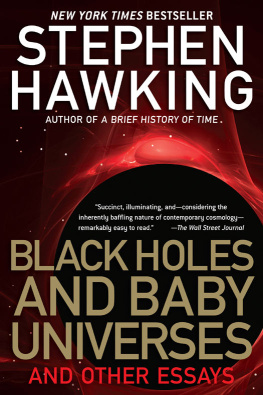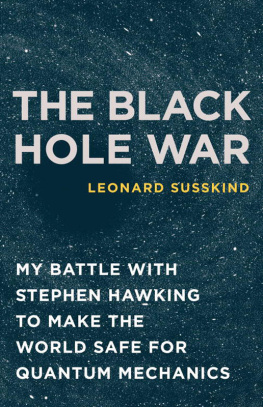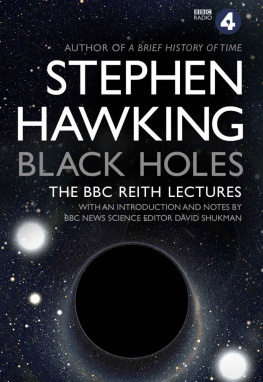The Theory of Everything: The Origin and Fate of the Universe
The Theory of Everything: The Origin and Fate of the Universe The Theory of Everything: The Origin and Fate of the UniverseBy Hawking, StephenINTRODUCTIONIn this series of lectures I shall try to give an outline of what we think is thehistory of the universe from the big bang to black holes. In the first lectureI shall briefly review past ideas about the universe and how we got to ourpresent picture. One might call this the history of the history of the universe.In the second lecture I shall describe how both Newtons and Einsteins the-ories of gravity led to the conclusion that the universe could not be static; ithad to be either expanding or contracting. This, in turn, implied that theremust have been a time between ten and twenty billion years ago when thedensity of the universe was infinite. This is called the big bang. It would havebeen the beginning of the universe.In the third lecture I shall talk about black holes. These are formed when amassive star or an even larger body collapses in on itself under its owngravitational pull. According to Einsteins general theory of relativity, anyonefoolish enough to fall into a black hole will be lost forever. They will not beable to come out of the black hole again. Instead, history, as far as they areconcerned, will come to a sticky end at a singularity. However, generalrelativity is a classical theory-that is, it doesnt take into account theuncertainty principle of quantum mechanics.In the fourth lecture I shall describe how quantum mechanics allows energy toleak out of black holes. Black holes arent as black as they are painted.In the fifth lecture I shall apply quantum mechanical ideas to the big bang andthe origin of the universe. This leads to the idea that space-time may be finitein extent but without boundary or edge. It would be like the surface of theEarth but with two more dimensions.In the sixth lecture I shall show how this new boundary proposal could explainwhy the past is so different from the future, even though the laws of physics aretime symmetric.Finally, in the seventh lecture I shall describe how we are trying to find aunified theory that will include quantum mechanics, gravity, and all the otherinteractions of physics. If we achieve this, we shall really understand theuniverse and our position in it.
The Theory of Everything: The Origin and Fate of the Universe
Chapter 1 - FIRST LECTURE - IDEAS ABOUT THE UNIVERSE
As long ago as 340 B.C. Aristotle, in his book On the Heavens, was able toput forward two good arguments for believing that the Earth was a roundball rather than a flat plate. First, he realized that eclipses of the moon werecaused by the Earth coming between the sun and the moon. The Earths shad-ow on the moon was always round, which would be true only if the Earth wasspherical. If the Earth had been a flat disk, the shadow would have been elon-gated and elliptical, unless the eclipse always occurred at a time when the sunwas directly above the center of the disk.Second, the Greeks knew from their travels that the Pole Star appeared lowerin the sky when viewed in the south than it did in more northerly regions.From the difference in the apparent position of the Pole Star in Egypt andGreece, Aristotle even quoted an estimate that the distance around the Earthwas four hundred thousand stadia. It is not known exactly what length a sta-dium was, but it may have been about two hundred yards. This would makeAristotles estimate about twice the currently accepted figure.The Greeks even had a third argument that the Earth must be round, for whyelse does one first see the sails of a ship coming over the horizon and only latersee the hull? Aristotle thought that the Earth was stationary and that the sun,the moon, the planets, and the stars moved in circular orbits about the Earth.He believed this because he felt, for mystical reasons, that the Earth was thecenter of the universe and that circular motion was the most perfect.This idea was elaborated by Ptolemy in the first century A.D. into a completecosmological model. The Earth stood at the center, surrounded by eightspheres, which carried the moon, the sun, the stars, and the five planets knownat the time: Mercury, Venus, Mars, Jupiter, and Saturn. The planets themselvesmoved on smaller circles attached to their respective spheres in order toaccount for their rather complicated observed paths in the sky. The outermostsphere carried the so-called fixed stars, which always stay in the same positionsrelative to each other but which rotate together across the sky. What laybeyond the last sphere was never made very clear, but it certainly was not partof mankinds observable universe.Ptolemys model provided a reasonably accurate system for predicting thepositions of heavenly bodies in the sky. But in order to predict these positionscorrectly, Ptolemy had to make an assumption that the moon followed a paththat sometimes brought it twice as close to the Earth as at other times. Andthat meant that the moon had sometimes to appear twice as big as it usuallydoes. Ptolemy was aware of this flaw but nevertheless his model was generally,although not universally, accepted. It was adopted by the Christian church asthe picture of the universe that was in accordance with Scripture. It had thegreat advantage that it left lots of room outside the sphere of fixed stars forheaven and hell.A much simpler model, however, was proposed in 1514 by a Polish priest,Nicholas Copernicus. At first, for fear of being accused of heresy, Copernicuspublished his model anonymously. His idea was that the sun was stationary atthe center and that the Earth and the planets moved in circular orbits aroundthe sun. Sadly for Copernicus, nearly a century passed before this idea was tobe taken seriously. Then two astronomers-the German, Johannes Kepler, andthe Italian, Galileo Galilei-started publicly to support the Copernican theo-ry, despite the fact that the orbits it predicted did not quite match the onesobserved. The death of the Aristotelian-Ptolemaic theory came in 1609. Inthat year Galileo started observing the night sky with a telescope, which hadjust been invented.When he looked at the planet Jupiter, Galileo found that it was accompa-nied by several small satellites, or moons, which orbited around it. Thisimplied that everything did not have to orbit directly around the Earth asAristotle and Ptolemy had thought. It was, of course, still possible to believethat the Earth was stationary at the center of the universe, but that themoons of Jupiter moved on extremely complicated paths around the Earth,giving the appearance that they orbited Jupiter. However, Copernicusstheory was much simpler.At the same time, Kepler had modified Copernicuss theory, suggesting that theplanets moved not in circles, but in ellipses. The predictions now finallymatched the observations. As far as Kepler was concerned, elliptical orbits weremerely an ad hoc hypothesis-and a rather repugnant one at that becauseellipses were clearly less perfect than circles. Having discovered, almost by acci-dent, that elliptical orbits fitted the observations well, he could not reconcilewith his idea that the planets were made to orbit the sun by magnetic forces.An explanation was provided only much later, in 1687, when Newton pub-lished his Principia Mathematica Naturalis Causae. This was probably the mostimportant single work ever published in the physical sciences. In it, Newtonnot only put forward a theory of how bodies moved in space and time, but healso developed the mathematics needed to analyze those motions. In addition,Newton postulated a law of universal gravitation. This said that each body inthe universe was attracted toward every other body by a force which wasstronger the more massive the bodies and the closer they were to each other.It was the same force which caused objects to fall to the ground. The story thatNewton was hit on the head by an apple is almost certainly apocryphal. AllNewton himself ever said was that the idea of gravity came to him as he sat ina contemplative mood, and was occasioned by the fall of an apple.Newton went on to show that, according to his law, gravity causes the moonto move in an elliptical orbit around the Earth and causes the Earth and theplanets to follow elliptical paths around the sun. The Copernican model gotrid of Ptolemys celestial spheres, and with them the idea that the universe hada natural boundary. The fixed stars did not appear to change their relative posi-tions as the Earth went around the sun. It therefore became natural to supposethat the fixed stars were objects like our sun but much farther away. This raiseda problem. Newton realized that, according to his theory of gravity, the starsshould attract each other; so, it seemed they could not remain essentiallymotionless. Would they not all fall together at some point?In a letter in 1691 to Richard Bentley, another leading thinker of his day,Newton argued that this would indeed happen if there were only a finite num-ber of stars. But he reasoned that if, on the other hand, there were an infinitenumber of stars distributed more or less uniformly over infinite space, thiswould not happen because there would not be any central point for them tofall to. This argument is an instance of the pitfalls that one can encounterwhen one talks about infinity.In an infinite universe, every point can be regarded as the center because everypoint has an infinite number of stars on each side of it. The correct approach,it was realized only much later, is to consider the finite situation in which thestars all fall in on each other. One then asks how things change if one addsmore stars roughly uniformly distributed outside this region. According toNewtons law, the extra stars would make no difference at all to the originalones, and so the stars would fall in just as fast. We can add as many stars as welike, but they will still always collapse in on themselves. We now know it isimpossible to have an infinite static model of the universe in which gravity isalways attractive.It is an interesting reflection on the general climate of thought before thetwentieth century that no one had suggested that the universe was expandingor contracting. It was generally accepted that either the universe had existedforever in an unchanging state or that it had been created at a finite time inthe past, more or less as we observe it today. In part, this may have been dueto peoples tendency to believe in eternal truths as well as the comfort theyfound in the thought that even though they may grow old and die, the uni-verse is unchanging.Even those who realized that Newtons theory of gravity showed that the uni-verse could not be static did not think to suggest that it might be expanding.Instead, they attempted to modify the theory by making the gravitational forcerepulsive at very large distances. This did not significantly affect their predic-tions of the motions of the planets. But it would allow an infinite distributionof stars to remain in equilibrium, with the attractive forces between nearbystars being balanced by the repulsive forces from those that were farther away.However, we now believe such an equilibrium would be unstable. If the starsin some region got only slightly near each other, the attractive forces betweenthem would become stronger and would dominate over the repulsive forces.This would mean that the stars would continue to fall toward each other. Onthe other hand, if the stars got a bit farther away from each other, the repul-sive forces would dominate and drive them farther apart.Another objection to an infinite static universe is normally ascribed to theGerman philosopher Heinrich Olbers. In fact, various contemporaries ofNewton had raised the problem, and the Olbers article of 1823 was not eventhe first to contain plausible arguments on this subject. It was, however, thefirst to be widely noted. The difficulty is that in an infinite static universenearly every line or side would end on the surface of a star. Thus one wouldexpect that the whole sky would be as bright as the sun, even at night. Olbersscounterargument was that the light from distant stars would be dimmed byabsorption by intervening matter. However, if that happened, the interveningmatter would eventually heat up until it glowed as brightly as the stars.The only way of avoiding the conclusion that the whole of the night skyshould be as bright as the surface of the sun would be if the stars had not beenshining forever, but had turned on at some finite time in the past. In that case,the absorbing matter might not have heated up yet, or the light from distantstars might not yet have reached us. And that brings us to the question of whatcould have caused the stars to have turned on in the first place.THE BEGINNING OF THE UNIVERSEThe beginning of the universe had, of course, been discussed for a long time.According to a number of early cosmologies in the Jewish/Christian/Muslimtradition, the universe started at a finite and not very distant time in the past.One argument for such a beginning was the feeling that it was necessary tohave a first cause to explain the existence of the universe.Another argument was put forward by St. Augustine in his book, The City ofGod. He pointed out that civilization is progressing, and we remember whoperformed this deed or developed that technique. Thus man, and so also per-haps the universe, could not have been around all that long. For otherwise wewould have already progressed more than we have.St. Augustine accepted a date of about 5000 B.C. for the creation of the uni-verse according to the book of Genesis. It is interesting that this is not so farfrom the end of the last Ice Age, about 10,000 B.C., which is when civilizationreally began. Aristotle and most of the other Greek philosophers, on the otherhand, did not like the idea of a creation because it made too much of divineintervention. They believed, therefore, that the human race and the worldaround it had existed, and would exist, forever. They had already consideredthe argument about progress, described earlier, and answered it by saying thatthere had been periodic floods or other disasters that repeatedly set the humanrace right back to the beginning of civilization.When most people believed in an essentially static and unchanging universe,the question of whether or not it had a beginning was really one of meta-physics or theology. One could account for what was observed either way.Either the universe had existed forever, or it was set in motion at some finitetime in such a manner as to look as though it had existed forever. But in 1929,Edwin Hubble made the landmark observation that wherever you look, distantstars are moving rapidly away from us. In other words, the universe is expand-ing. This means that at earlier times objects would have been closer together.In fact, it seemed that there was a time about ten or twenty thousand millionyears ago when they were all at exactly the same place.This discovery finally brought the question of the beginning of the universeinto the realm of science. Hubbles observations suggested that there was atime called the big bang when the universe was infinitesimally small and,therefore, infinitely dense. If there were events earlier than this time, thenthey could not affect what happens at the present time. Their existence can beignored because it would have no observational consequences.One may say that time had a beginning at the big bang, in the sense that ear-lier times simply could not be defined. It should be emphasized that this begin-ning in time is very different from those that had been considered previously.In an unchanging universe, a beginning in time is something that has to beimposed by some being outside the universe. There is no physical necessity fora beginning. One can imagine that God created the universe at literally anytime in the past. On the other hand, if the universe is expanding, there maybe physical reasons why there had to be a beginning. One could still believethat God created the universe at the instant of the big bang. He could evenhave created it at a later time in just such a way as to make it look as thoughthere had been a big bang. But it would be meaningless to suppose that it wascreated before the big bang. An expanding universe does not preclude a cre-ator, but it does place limits on when He might have carried out his job.
Next page
